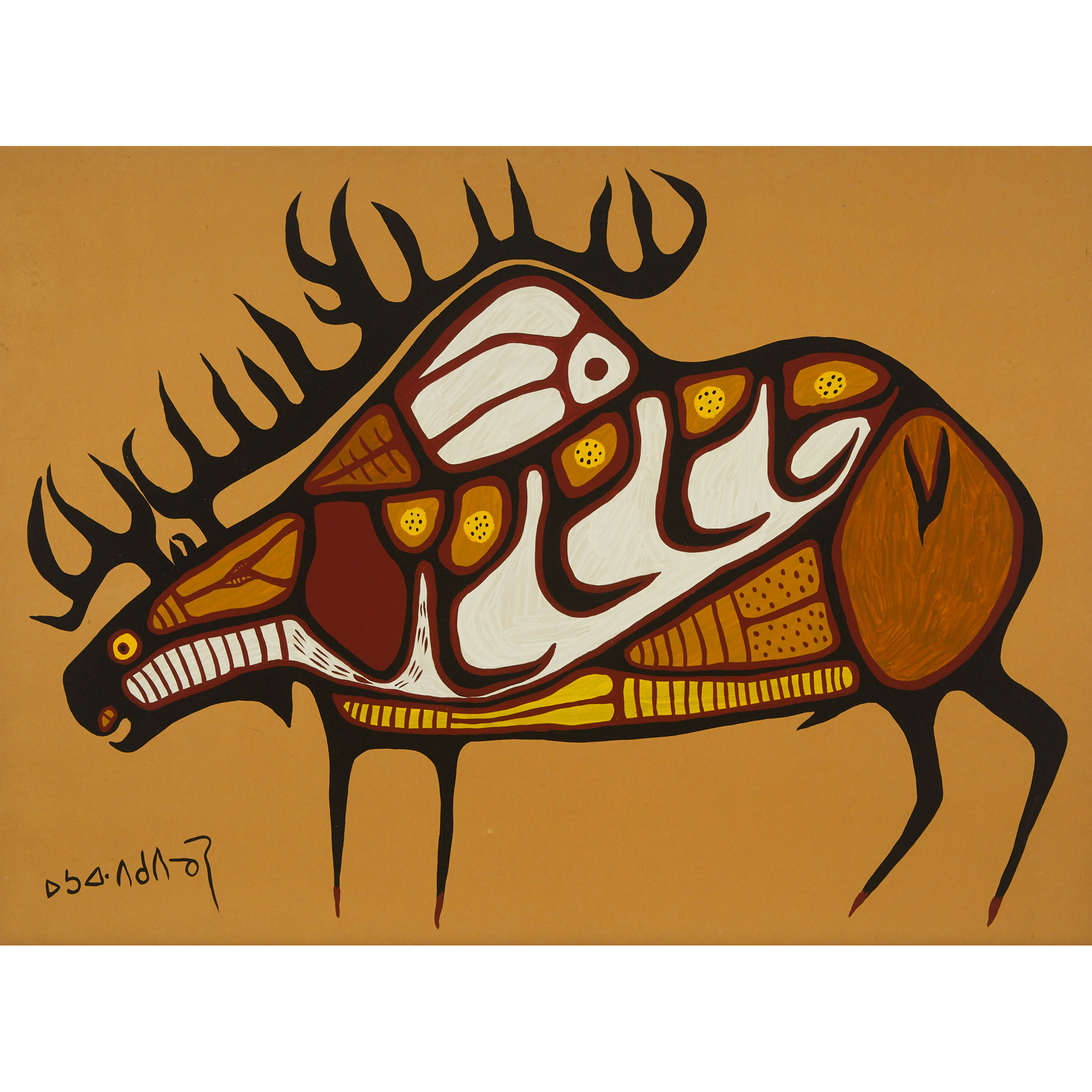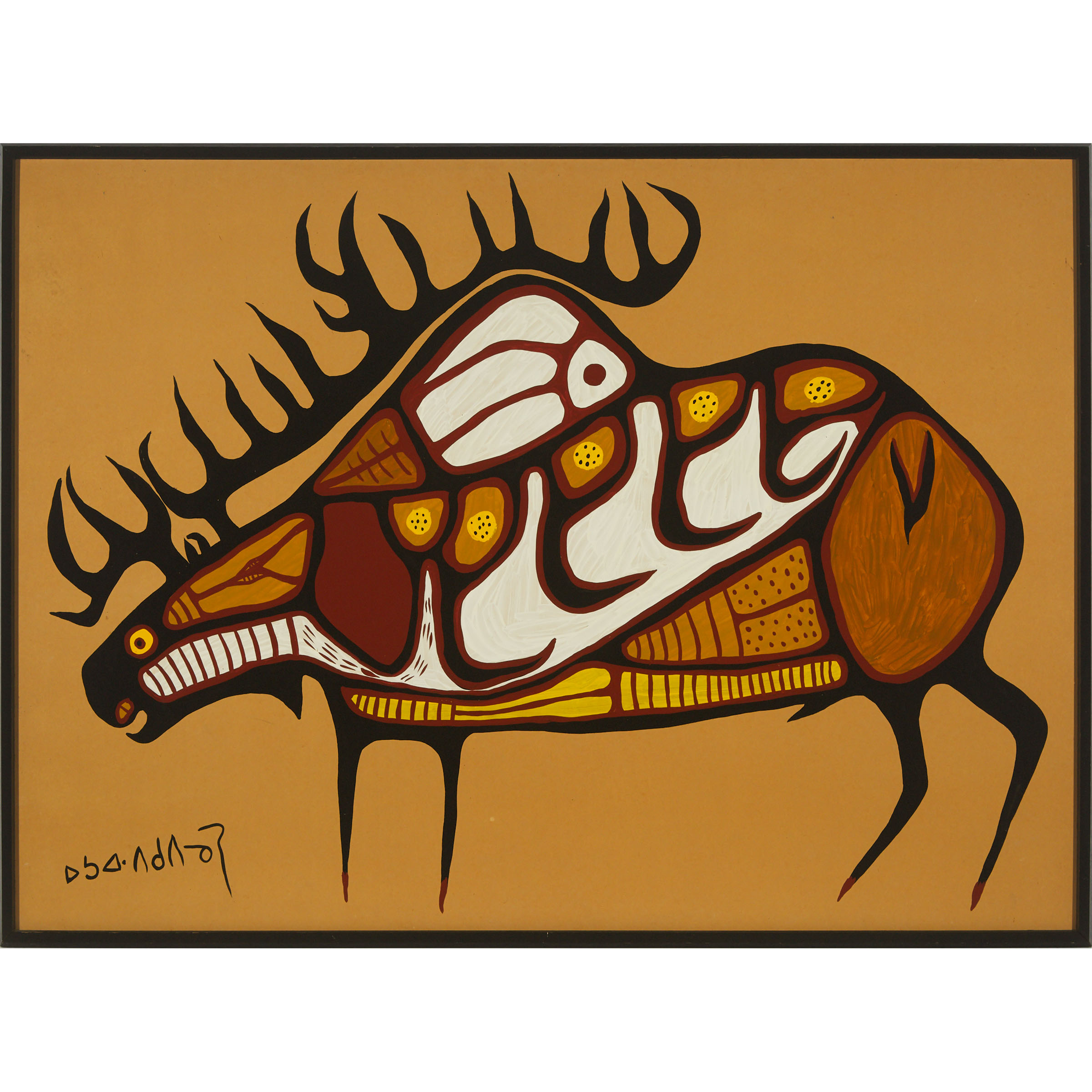Lot 58
Norval Morrisseau, RCA (1932-2007), Anishinaabe (Ojibwe)

Lot 58 Details
Norval Morrisseau, RCA (1932-2007), Anishinaabe (Ojibwe)
MOOSE
acrylic on kraft paper on board
signed in syllabics
39.5 x 55 in — 100.3 x 139.7 cm
Estimate $10,000-$15,000
Realised: $13,530
Additional Images

Provenance:
Acquired directly from the artist;
Estate of Robert Lavack, North Bay, ON
This painting was purchased directly from Norval Morrisseau by Robert Lavack, and comes accompanied by a signed letter from Lavack in support of provenance.
Lavack was posted to North Bay during his time working for the Ontario Department of Education. In North Bay, he met Morrisseau, and the two men became friends. Lavack was a great supporter of the artist’s work, helping to arrange art tours between 1970-1972.
Note:
Moose is indicative of Morrisseau’s muted, umber-based colour palette that can be found in several of his works from the early 1970s. Viewers can see his singular visual philosophy where thick bands of black line contain flat blocks of colour and rhythmic shapes. The outline of the moose nearly fills the entire composition, from top to bottom and side-to-side. The moose’s heart is placed slightly above the animal’s two legs and is displayed as an opaque object coloured in burnt umber. Small streaks of burnt umber circulate below the heart to illustrate the blood pumping through its body and the vitality of its being. But what is perhaps most remarkable about this painting is the rendering of the antlers, which defy logic by crawling along the back hunch of the moose while reaching like talons towards the sky above. This, coupled with its fiery yellow eyes, create a picture of an animal that is wondrously alive and moving through space.
Morrisseau’s use of white paint in the moose should not be taken at face value. His liberal application of it not only serves to accentuate the interior of the moose and particularly its ribs, but it also demonstrates how figure and ground can coalesce in Woodland Art to produce X-Ray-like perspectives. His delineation of the external and internal workings of humans, animals, and objects stand as a radically different optical logic to seeing and experiencing the world. As such, it lies in marked contrast to the multi-point perspective discovered during the Italian Renaissance.
Morrisseau painted several depictions of moose throughout his lifetime. Some were based on dreams that visited him at night while some were sourced from the dreams of others. That being said, the inspiration behind this painting remains unknown. The etymology of moose is derived from the Anishinaabe word “moonz.” It is commonly translated into the English language as “one who strips off leaves and bark” or “twig-eater.” For the Anishinaabe people, moose function as a food staple and a critical mode of survival – the entire body of the animal is consumed as food or for instrumental use; for example, its sinew is used for making snowshoes and its hide for clothing. Moose also serve as a clan animal in systems of governance and as a spiritual figure of abundance, endurance, and survival. In this light, perhaps, Morrisseau’s painting articulates the prospect of hope itself, a positive affirmation for the future.
Matthew Ryan Smith, Ph.D., is a curator, writer, and editor of European descent. He is currently the Curator & Head of Collections of Glenhyrst Art Gallery, the literary editor of First American Art Magazine, and editorial board member of the Yearbook of Moving Image Studies at Kiel University, Germany.
References:
Matthew Ryan Smith. “The Neo-Woodland Movement,” First American Art Magazine, issue 30 (2021), 38-45.




